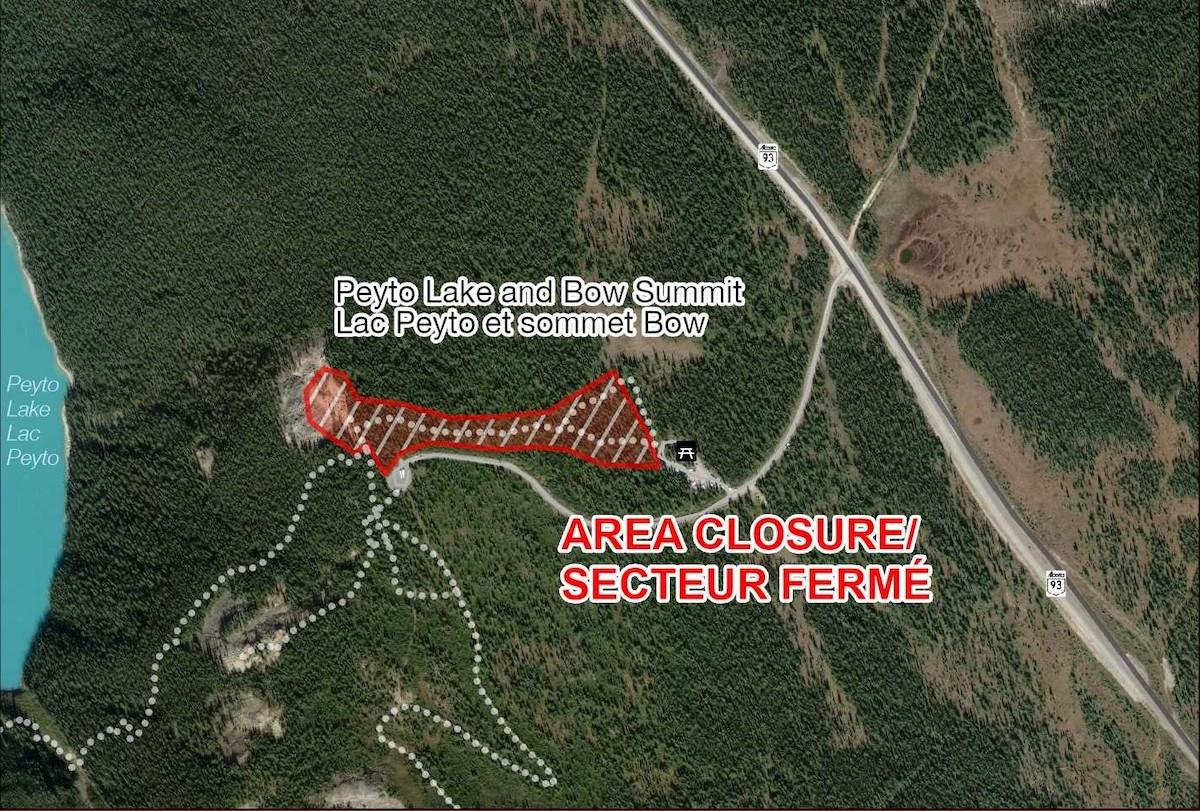
Visitors adore seeing a turquoise lake from the Peyto Lake viewpoint, which is closed until August/Parks Canada
One of the most popular viewpoints along the Icefields Parkway in Banff National Park will remain closed until August for a second summer of construction.
Hundreds of thousands of people have visited Peyto Lake each year since 1941 and now the federal government is investing $2.9 million ($2.3 million USD) to boost parking, improve traffic flow and replace aging restrooms.
“It’s never easy to close down a busy spot,” says Jed Cochrane, visitor experience manager for Parks Canada’s Lake Louise Yoho Kootenay Field Unit, which is responsible for the northern half of Banff. “But we really felt like with $2.9 million to invest into the facilities and into the area, this was the time to do it. It needed a bit of a facelift.”
Like Banff’s other famous glacier-fed alpine lakes — Moraine, Lake Louise and Bow — Peyto Lake is blessed with turquoise waters. The brilliant blue-green hue is created when sunlight refracts off the rock flour (fine rock particles) suspended in the glacier run-off.
Visitors usually pull off the Icefields Highway, one of the world’s most scenic drives, park in the Peyto Lake/Bow Summit day use area and walk to the viewpoint. It’s about five minutes from the upper lot and a bit longer from the lower one.
“It’s a stunning vista viewpoint of the iconic turquoise lakes with the beautiful mountain backdrop,” says Cochrane. What’s also unique here is that “it’s a little more of a glimpse from afar” from a platform with a clear view over the forest to the lake. The viewpoint is more than 2,000 metres (about 6,500 feet) above sea level and so people can't dip their toes in Peyto Lake.

A map shows the closure area at Peyto Lake/Bow Summit/Parks Canada
The mountainous area is covered in snow from mid-November until mid-June, with potential for avalanches, and so the construction season is brief, at best. The snow came sooner than expected in the fall, cutting the work season short.
The viewing platform, viewpoint and pedestrian trails to the viewpoint will remain closed through July 31. While the viewpoint may look nearly complete, Parks Canada reports that there are gaps in decking and guardrails alongside steep drops.
Barriers are in place and it’s illegal for anyone — motorists, cyclists, pedestrians and skiers — to enter. Under the Canada National Parks Act, people can be charged, sent to provincial court and fined up to $25,000 (almost $20,000 USD).
Cochrane says people were charged last year, although no information was available on their court cases or fines.

The new washroom building at the Peyto Lake/Bow Summit day use area will be accessible but will still have pit toilets/Parks Canada
Right now, the rehabilitated lower parking lot, new restroom and access roads at the Peyto Lake/Bow Summit day use area are open only for backcountry recreationalists, mainly ski touring visitors with avalanche safety training and appropriate equipment. It’s not possible to see the lake. These areas will all close in spring so contractors can resume work that includes rerouting trails from the lower parking lot, creating barrier-free access from the upper parking lot, installing new signage (this will include health and safety messaging), and creating visitor zones to better protect sensitive sub-alpine vegetation.
For winter, Parks Canada suggests people explore the Lake Louise lakeshore and designated snowshoe trails, mindful that you need snow tires, warm clothing and strong winter driving skills to travel on the Icefields Parkway at this time. For summer, it recommends the Bow Lake Viewpoint and Day Use Area, Mistaya Canyon Trail, Howse Pass Day Use Area, Parker Ridge Trail, Columbia Icefield Discovery Centre, Sunwapta Falls Day Use Area and Athabasca Falls Day Use Area.
In 2019, the Peyto Lake improvements first ran from September 16 to November 22. Last year, they ran April 22 to November 6. Peyto Lake is named for Bill Peyto, a mountain guide and former Banff National Park warden who died in 1943.
Bow Lake, six kilometres (3.7 miles) south of Peyto Lake/Bow Summit, is not affected by this work.

 Support Essential Coverage of Essential Places
Support Essential Coverage of Essential Places



